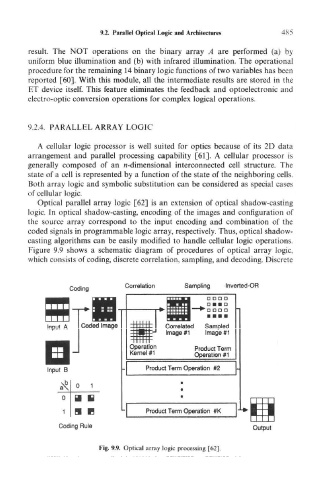Page 500 - Introduction to Information Optics
P. 500
9.2. Parallel Optical Logic and Architectures 485
result. The NOT operations on the binary array A are performed (a) by
uniform blue illumination and (b) with infrared illumination. The operational
procedure for the remaining 14 binary logic functions of two variables has been
reported [60]. With this module, all the intermediate results are stored in the
ET device itself. This feature eliminates the feedback and optoelectronic and
electro-optic conversion operations for complex logical operations.
9.2.4, PARALLEL ARRAY LOGIC
A cellular logic processor is well suited for optics because of its 2D data
arrangement and parallel processing capability [61]. A cellular processor is
generally composed of an ^-dimensional interconnected cell structure. The
state of a cell is represented by a function of the state of the neighboring cells.
Both array logic and symbolic substitution can be considered as special cases
of cellular logic.
Optical parallel array logic [62] is an extension of optical shadow-casting
logic. In optical shadow-casting, encoding of the images and configuration of
the source array correspond to the input encoding and combination of the
coded signals in programmable logic array, respectively. Thus, optical shadow-
casting algorithms can be easily modified to handle cellular logic operations.
Figure 9.9 shows a schematic diagram of procedures of optical array logic,
which consists of coding, discrete correlation, sampling, and decoding. Discrete
Coding Correlation Sampling Inverted-OR
Coding Rule Output
Fig. 9.9. Optical array logic processing [62].

